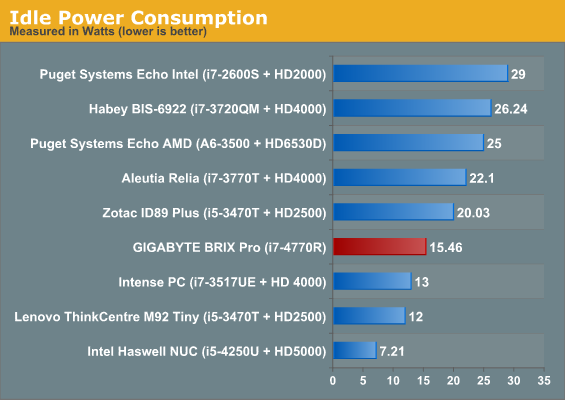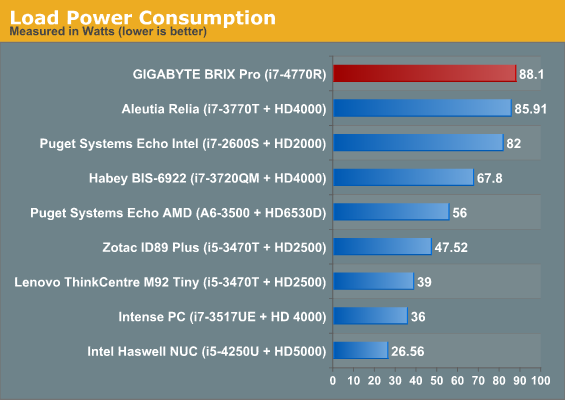GIGABYTE BRIX Pro: A First Look at the Intel i7-4770R with Iris Pro HD 5200
by Ganesh T S on January 7, 2014 8:00 PM EST
The presence of the Core i7-4770R in such a small form factor / chassis left us worried initially. We were wondering whether the unit would be able to properly cool down a 65W TDP processor within those constraints. Due to the size of the system, the fan had to be pretty small and rotate at high speeds for effective cooling. With a maximum speed of 4090 rpm, the sound from the unit was similar to what one would expect in a mini-server room (matching the noise from the Netgear GSM 7352S that we have running in our NAS testbed). While running various benchmarks, the speed topped out around 3900 rpm.
To stress the unit to the maximum, we unleashed our Prime 95 + FurMark stress test and recorded the following numbers.


At the outset, the idle numbers are impressive for a system with a 65W TDP desktop processor. Note that this is not a ULV CPU like what we had in the Intel NUC. The load numbers indicate a maximum power consumption of approximately 88W. I did see the instantaneous power consumption shoot up to 92 - 93W initially and attributed this to the Core i7-4770R's turbo mode (where the CPU clock can go up to as high as 3.9 GHz compared to the nominal 3.2 GHz). A look at the temperatures and HWiNFO throttling information, however, confirmed what we had feared.
Gallery: GIGABYTE BRIX Pro
The unit does seem to throttle under full load of both the CPU and GPU (an unrealistic workload, admittedly, but one which some of the other systems we have evaluated have passed with flying colours). Now, the results that we obtained for the four passes of our x264 benchmark run were pretty consistent. It might turn out that normal workloads don't trigger the throttling and it is something we hope to evaluate further down the road.














98 Comments
View All Comments
DIYEyal - Tuesday, January 7, 2014 - link
I could use something like that for editing on the go, much smaller than any mITX system.. Much cheaper than a laptop with similar specs.. I could plug it to the hotel's TV via HDMI and get some editing done (weird configuration, I know)CharonPDX - Tuesday, January 7, 2014 - link
Re: "One of the interesting aspects in the press release was the reference to 64 MB of eDRAM on the Iris Pro HD 5200.".Apple doesn't just "imply", they outright state it: "The 15‑inch MacBook Pro has a phenomenal display — with the graphics power to match. Its fourth-generation Intel Core i7 processor features Iris Pro Graphics with 128MB of embedded memory, which accelerates processor- and graphics-intensive tasks by acting as an ultrafast cache. "
But the Retina MacBook Pro uses the mobile chip, not the desktop chip. Maybe the desktop chip only has 64 MB?
JohnHardkiss - Tuesday, January 7, 2014 - link
Interesting. It would be gold if these seemingly contradictory bits of information would be settled.Daedalus1 - Tuesday, January 7, 2014 - link
I have been waiting for a NUC or similar to come out with the 5200 Iris Pro graphics for some time. At last. And then disappointment, it only supports 2 monitors not 3.Oh well maybe I just have to go the AsRock mini iTX route after all.
Daedalus
kgh00007 - Tuesday, January 7, 2014 - link
Great, I've been waiting for you guys to get a hold if one of these, I'm looking forward to part 2!I would also like to request a 1080p gaming benchmark, at low or medium details, this thing will likely be connected to a 1080p HDTV afterall, that's what interests me the most!
And maybe a look at the preformance difference between 8GB and 16GB RAM configurations if any!
ryrynz - Tuesday, January 7, 2014 - link
I think you could just look up any review of the difference between 8 and 16, there's not much.. which is why I haven't bothered moving to 16.DarkXale - Wednesday, January 8, 2014 - link
RAM benefits are binary.You either have too much, or too little. In the case of games its generally an easy answer; unless you're at 4GB, or rare cases 6GB, you have too much. Its still exceptionally rare for a game to be 64-bit, and they are thus incapable of addressing more than 4GB. The rest is simply up to the system & background tasks.
However, its always preferable to have too much RAM - than too little. Too much generally just means that you ended up paying a bit more - too little means extreme swapping, utterly annihilating performance.
8GB as such is the sweet spot, because its a level which is difficult to reach without the use of specific software - but cheap enough that going down to the 6GB or 4GB levels saves almost no money on a home-build setup.
lco45 - Monday, January 20, 2014 - link
Nicely put.8steve8 - Tuesday, January 7, 2014 - link
1. gigabytes own specs list 3200x2000 @ 60 Hz the max resolution on the displayport...why, it's DP 1.2? This would exclude it for use with all the new 4k LCD's coming our soon.
2. a few gaming benchmarks would be appreciated... part of the allure of this is that it's a tiny workstation that can also kind of play games.
Samus - Tuesday, January 7, 2014 - link
Wow this little thing is amazing.